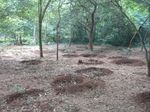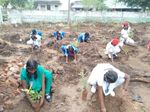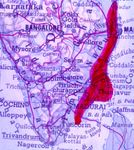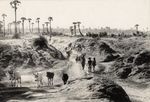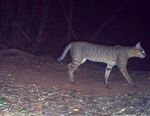Auroville Greenwork in the larger context of Bioregional Conservation
←
→
Page content transcription
If your browser does not render page correctly, please read the page content below
14 December 2021
Auroville Greenwork in the larger context
of Bioregional Conservation
Auroville and the TDEF
Auroville is situated in the coastal region of south-eastern
peninsular India which has a vegetation type defined as
Tropical Dry Evergreen Forest – TDEF (Champion and
Seth 1968). It has a narrow range, approximately 500 km
long running north to south, and with a width no wider
than 50km. In 2002 it was estimated that only 4% of this
TDEF range was under forest cover, but the results of
field studies carried out showed that only 5% of the
remaining forest was actually pristine TDEF, with the
other 95 % being highly disturbed, with a classification of
degraded scrub. Therefore, it would be fair to state that
only 0.2% of this range now exists as an ecosystem, and
consequently making it a very rare forest type in India, if
not the rarest due to its anyway limited range. The
circumstances which have left this forest system in a
fragile state are many, but mainly the high concentration
of human population in this coastal belt and the impact
that has on the environment.
114 December 2021
The TDEF, like most tropical forests, contain large
amounts of species and biodiversity, it is estimated that
up to a 1000 different plant species make this forest type
their home with 300 of these being woody. The forest
type has adapted to being in cyclonic region, with a
relative low canopy of 8 to 10 metres with the occasional
emergent tree. The canopy is rich with inter linked lianas
and the forest floor is a rich layer of biomass that is
effectively recycled by plant feeder roots in the top 1cm of
soil. The TDEF, like classical tropical forests hold its
nutrient wealth in the canopy, thus once cut the soil
becomes impoverished and quickly leached by the region’s
intense monsoon rains. A forest type is not only the flora,
the plants that are present within the ecosystem, but also
the fauna, the mammals, birds, reptiles and insects that
survive and thrive in this habitat. In the past leopards and
elephant herds would have roamed these regions, perhaps
even tigers, but today the TDEF is home to smaller
mammals, the mongoose, porcupine, Indian civet cat,
jungle cat, and many more including the fruit bat which is
an important vector for spreading seeds of the forest. The
TDEF also is home to a large population of reptiles and a
myriad of bird species that gain protection from the
dense habitat the TDEF offers, but it also gives place for
the insects to thrive, the pollinators, which are now
proving to be key elements of any environment where be
natural plant areas or manmade ones such as agriculture.
The Sacred Groves
The last remnants of the TDEF, which indicate a primary
forest, exist in sacred groves that are found around
temples, generally of the deity Ayyaner but not
exclusively. These shrines situated outside villages and the
with the religious cultural belief system that the god
enjoyed hunting and being in the forest at night meant
that pockets of forest around the temple were kept,
protected and held sacred. These groves vary in size,
214 December 2021
sometimes less than hectare but others up to 10 hectares,
during our studies in the late 90’s up 75 sacred groves were
analysed and researched, and thus became the bio-
resource, both in knowledge and seed source for the
restoration and re-establishment of the TDEF within the
Auroville community. This effort became the main focus
of our environmental work here in Auroville, an effort to
established protected pockets of this endangered forest
type and the rich heritage of its biodiversity held within
it.
Auroville’s Greenwork
Auroville came into being in 1968, the plateau that was to
become the city the earth needs was an eroded, barren
landscape devoid of trees, other than some palmyras and a
few banyans. The initial challenge for the community
members was to create a hospitable environment to live
and work in, at that point there was no large
environmental wisdom or vision, it was basic human
necessity, that water and shade were required and the
effort started. Soil and water conservation measures were
implemented and trees were planted in a passionate,
though albeit haphazard way. As the decades progressed
there soon emerged an Auroville forest, which was a
mishmash of exotic and native species, the hardy ones
that could survive those initial tough pioneer conditions.
It was only in the mid to late 90’s after the in-depth study
of the indigenous vegetation, that the TDEF was
introduced en masse within Auroville, utilising the shade
and biomass the initial pioneer species offer. This became
the single planting focus of the group involved in
coordinating environmental work which has accumulated
today in the planting of half a million TDEF saplings.
It is now apparent that the Auroville plateau contains the
largest contiguous area of TDEF, though it is not old
growth but a young forest, it is starting to mature, and to
regenerate. The regenerating factor is a good indicator of
protection, and also that from a limited genetic stock of
314 December 2021
plants from our region, it is not only surviving but
flourishing.
The status of the TDEF
Putting the Auroville area of TDEF into context with the
whole zone doesn’t really indicate the present day status
of the forest. For this understanding there is presently a
research project underway which aims at understanding
what is the current status of TDEF. Part of this entailed
revisiting the sacred groves that were studied 25 years ago
with the view of doing a comparative study. Though this
study is not complete and published, certain conclusions
are clear; the nature of a sacred grove and their land status
means that these areas have not increased in area, that
about 25% of the groves are in fairly static state, well
protected and have maintained a similar canopy cover, the
remaining 75% it was observed that there is some level of
disturbance which has led to a reduction in their canopy
cover. From these findings it can be said that the status of
the TDEF forest reference its spatial distribution across
its range is still in decline.
Future partnership
As Auroville is now holding and protecting rare
biodiversity material in its forests it means that this
heritage is not lost. There is a clear will to understand the
dynamics of how this status of the TDEF can not only be
held in check but improved. This could mean using the
seeds from plants within Auroville to create seedlings
which can be spread back into the bioregion. Projects
have already started to do this on a small scale and there
is a will to now give back to the bioregion and thus not
only protect the TDEF but to help it thrive and grow.
Prepared by Glenn Baldwin - Auroville Forest Group 14/12/2021
4You can also read




